London’s River: Conrad, Whistler, and The Metropolitan Magazine
Joanna Meacock, Glasgow Museums
© Joanna Meacock. No part of this text may be reposted or republished without the permission of the author.
[7,286 words]
Joseph Conrad had an innate visual sense, describing himself in 1904 to artist William Rothenstein as “powerfully affected” by a one-man show of paintings and drawings by Augustus John, possibly at the Carfax Gallery in London.1 In February of the following year, Conrad’s essay “London River” was published in The Metropolitan Magazine with a selection of etchings of the Thames by the American artist James McNeill Whistler (Figure 1), 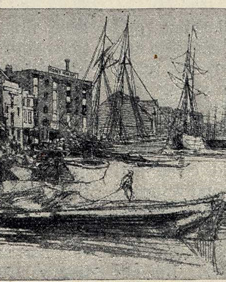
a figure of considerable critical reputation on the international art scene who had pushed the boundaries of what constituted a finished work of art and focused in an unprecedented way on the formal values of painting, on form, line, and colour.2 As an etcher, he was daring and experimental, and his works were frequently likened in technique and accomplishment to those of Rembrandt. Reviewing Conrad’s The Mirror of the Sea (1906), in which “London River” was later collected, The Academy notably commented on Conrad’s natural affinities with the artist, writing that Conrad “persistently speaks of the sea and seamanship in terms of art”.3 Both Whistler and Conrad were drawn to the River Thames, its workers and workings, Conrad as a master mariner in the British merchant navy and Whistler initially under the influence of Realism, although later in his career he would transform the riverside into a veiled, evocative world of nocturnal beauty. This essay seeks to examine this auspicious union of artistic and literary giants, Whistler and Conrad, their shared backgrounds, contacts and artistic direction, discussing the success and import of their juxtaposition on the pages of The Metropolitan Magazine.
Both Whistler (1834–1901) and Conrad (1857–1924) were migrants with Russian histories. Whistler, born in Lowell, Massachusetts, spent time as child, aged nine to fourteen (1843–48), in St Petersburg where his father worked as an engineer on the Russian railway for Tsar Nicholas I; during the Ruskin trial of 1878, Whistler actually claimed to have been born here.4 Conrad, born in the Russian Ukraine, moved at the age of four to the remote Russian province of Vologda with his Polish parents who had become political exiles. Both Whistler and Conrad were sickly as children, intelligent but disliking the rigour and discipline of school. Both lost their fathers as young boys, Whistler aged fourteen and Conrad aged eleven (Conrad had also lost his mother four years previously). Whistler, who from the age of fourteen had decided on a career in art, went to Paris to train as an artist in 1855 to 1858. From the age of thirteen Conrad wanted to be a sailor and set off for Marseilles at sixteen. Both were fluent in French yet chose Britain as their homeland and place of creative inspiration; Conrad naturalised in 1886, but Whistler never renounced his American citizenship. Bizarrely, both may have participated in illegal but profitable gun-running expeditions to South America, Whistler in 1866 to Chile, then at war with Spain, and Conrad in 1876 to Colombia to aid the conservative Catholic rebels in that country’s civil war.5 1878 saw both men in trouble: Conrad, in debt, apparently attempted suicide with a pistol; Whistler took out a libel action against John Ruskin for his comments in Fors Clavigera, leading to the artist’s bankruptcy in 1879.6
They were men of equally sharp wit and tongue. Rothenstein described Conrad as “by birth and by choice, an aristocrat” and commented that “nerves sometimes made him aggressive, almost violent”.7 Whistler, too, was known to throw punches, literally as well as figuratively, and although from a firmly middle class background, was an aristocrat in matters of art: “let not the working man drop the sweat of his brow upon the Elgin Marbles” was his notorious response in 1878 to a man petitioning for the Sunday opening of the National Gallery.8 In his celebrated “Ten O’Clock Lecture”, delivered at Prince’s Hall in Picadilly, London on 20 February 1885, and later published, he noted “the disastrous effect of Art upon the Middle Classes”.9
Whistler’s death in 1903 prompted large memorial exhibitions of his paintings, watercolours, pastels, etchings, and lithographs in Boston (February 1904), London (February–April 1905) and Paris (May 1905).10 Several biographies were already in preparation and a large number of articles discussing the man, his art, and his legacy had been published. In this context the decision to illustrate Conrad’s article in The Metropolitan Magazine (Figure 2)
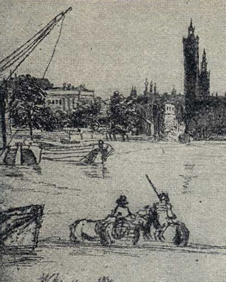
with Whistler etchings could be seen as an astute commercial move on the part of the editor, John Kendrick Bangs (1862–1922), and owner, George Brinton McClellan Harvey (1864–1928) The Metropolitan Magazine, although founded in 1895, had not really asserted itself as a serious magazine until 1903 when it came under the latter’s ownership; Harvey already owned several successful newspapers, including the North American Review and Harper’s Weekly.11 Commercial interests certainly came into play. In a letter dated 18 April 1904 to James Brand Pinker—Conrad’s friend and literary agent, who was also the exclusive agent of Henry James, and short-time agent for Oscar Wilde, both closely connected to Whistler—Conrad suggested that the publication of “London River” was intended to help sales of his 1904 novel Nostromo.12
However, I would like to propose that there was more going on. Among the articles published following Whistler’s death was a piece by Max Beerbohm on the artist’s writings, which appeared in The Metropolitan Magazine in September 1904. In this article Beerbohm noted that painting and writing “are marvellously akin; and such differences as you will see in them are superficial merely.”13 I would argue that there was a kinship between Whistler the artist and Conrad the writer that made juxtaposition of text and image natural and harmonious.
The connections between Whistler and Conrad run deep. One wonders whether the publisher William Heinemann (1863–1920) recommended Whistler to Conrad or Harvey. His London publishing house, which opened in 1890, had brought out a number of Conrad’s novels, including the rather unpalatably named The Nigger of the “Narcissus” on 2 December 1897.14 One of Heinemann’s first publications had been Whistler’s, equally unpalatable for some, The Gentle Art of Making Enemies. After this volume’s publication in June 1890, Whistler and Heinemann became close. When Whistler’s wife Beatrix died in 1896, Whistler stayed with the publisher in his London home and in February 1899 was best man at the Heinemann wedding in Porto d’Anzio in Italy. Whistler designed a stylish monogram for Heinemann around 1898 and, after his marriage, for his wife Magda.15 In 1898–1999 he was commissioned to paint a Portrait of Mrs Heinemann, which unfortunately remained unfinished.16 In 1908 Heinemann went on to publish Elisabeth and Joseph Pennell’s authoritative biography, Life of James McNeill Whistler, a book that was in preparation in 1905.17
When “London River” was published in The Metropolitan Magazine in 1905, it was subtitled “Illustrated from the ‘Thames Series’ of Etchings by James McNeill Whistler”. This was not entirely true. Eight of the etchings came from “A Series of Sixteen Etchings of Scenes on the Thames”, published in 1871 by Frederick Standridge Ellis (1830–1901) of Ellis & Green, London. The fourth etching Billingsgate (1859) was not part of this “Thames Set”, despite having been executed at the same time as the series; all date from 1859, with the exception of Rotherhithe which dates from 1860. However, Billingsgate (Figure 3),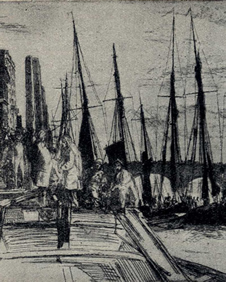
a crowded scene showing Billingsgate fish market on the north bank to the left and London Bridge and St Saviour’s, Southwark visible in background, is a completely understandable addition.18 It was published in its eighth state by Philip Gilbert Hamerton in The Portfolio in January 1878 (pp. 8–9), at which time The Standard declared it “an exceedingly vivid and powerful etching, […] one of the finest plates that has been published in the periodical since it started.”19 Whistler’s Thames etchings were all critically acclaimed at the time for their absolute mastery of the etching medium and for their close observation of river life and attention to detail and texture, and, subsequently, for an anti-academic approach to pictorial space that was influenced most notably by Japanese ukiyo-e prints and early photography.
The etchings for the article came from the New York publisher and print dealer Frederick Keppel (1845–1912) of Keppel & Co. He had acquired the copper plates of Whistler’s Thames Set in the late 1880s and had subsequently published them in a ‘limited’ edition.20 A Whistler enthusiast, he had bought a large number of Whistler etchings in the 1890s, especially rarities such as first editions and trial proofs. In 1904 Keppel held an exhibition of Whistler’s prints and drawings that included impressions of all of the etchings reproduced in the Metropolitan Magazine in 1905: no. 26, Thames Warehouses (G.46); no. 27, [Old] Westminster Bridge (G.47); no. 28; Billingsgate (G.51); no. 32, Rotherhithe (Wapping) (G.70); no. 35, Limehouse (G.48); no. 36, Eagle Wharf (G.50); no. 37, Black Lion Wharf (G.54); no. 38, The Pool (G.49); and no. 39, Thames Police (Custom House) (G.53). The exhibition was accompanied by a catalogue with an introduction by Joseph Pennell, which opened with the assertion that “Whistler was the greatest etcher and the most accomplished lithographer who ever lived.”21
In the same year Keppel brought out a couple of other publications on Whistler. In The Gentle Art of Resenting Injuries; being some Unpublished Correspondence Addressed to the Author of “The Gentle Art of Making Enemies”,Keppel sought to readdress a wrong of 1896, when Whistler had fallen out with him over the publication of a “libellous little book”, Walter Greenwood Forsyth and Joseph LeRoy Harrison’s Guide to the Study of James Abbott McNeill Whistler, which Keppel had forwarded to Whistler, Ernest G. Brown, and Joseph Pennell.22 In “One Day with Whistler” (The Reader, January 1904), Keppel recalled his first meeting with Whistler, when he was invited into his studio and home. Keppel writes: “Whistler has often been called the greatest painter of his day – and he was always called the greatest etcher.”23 Despite any perceived wrongs Keppel appears to have held no lasting grudge and continued to promote Whistler and particularly his etchings—although it should be noted that he, too, had commercial interests here.
Interestingly, Conrad’s close friend William Rothenstein (1872-1945) was a former disciple of Whistler’s. Rothenstein had met Whistler in Paris at the home of another American, Miss Ruebell, in the winter of 1890/1891, and had been subsequently invited to Whistler’s Sunday breakfasts at the rue du Bac.24 Rothenstein had first encountered the work of Whistler at a retrospective exhibition of paintings, etchings and pastels at the College for Working Men and Women in Russell Square, London in May 1889, organised by Rothenstein’s friend and fellow Whistler protégé Walter Sickert.25 It included the influential Arrangement in Grey and Black, No. 2: Portrait of Thomas Carlyle (1872-1873, oil, Glasgow Museums).26 Rothenstein’s early compositions show a definite Whistlerian influence, notably Edward Gordon Craig (1872–1966), as Hamlet in “Hamlet” by William Shakespeare (1896, oil, V&A), which looks to Whistler’s shadowy Velásquezian portraits of the 1870s and 1880s. But also The Browning Readers (1900, oil, Bradford Museums and Galleries) and Mother and Child (1903, oil, Tate), which, with their figures in interiors, sense of balance and poise, and art on the walls, show the conjoint influences of Whistler and Edgar Degas. Through Whistler, Rothenstein was introduced to the technique of lithography. He made a couple of pen and ink sketches of Whistler in 1894, including Sketch of Whistler, Whilst He was Retouching a Stone, Paris (Art Institute of Chicago).27 Championing the work of the master, Rothenstein attempted to persuade the City of Bradford to purchase works by Whistler while he was serving on the inaugural exhibition committee of Cartwright Hall in 1904.28
The relationship between Whistler and Rothenstein was, however, troubled. Whistler’s rather condescending behaviour towards the younger man is highlighted in their 1890s correspondence, throughout which he refers to Rothenstein as “my dear Parson”, “my dear Vicar” or “Your Reverence”, an allusion to the “unsophisticated Parson” in The Parson and the Painter (1891), written by the Reverend Joseph Slapkins (pseud. Alfred Allison) and illustrated by Charles Summers (pseud. Phil May).29 Such jibes were particularly irksome considering Rothenstein’s Jewish heritage. Trouble continued when in 1896 Whistler questioned Rothenstein’s loyalty over the acceptance of work by Sir William Eden into the New English Art Club and there were disagreements in the early years of the International Society of Sculptors, Painters and Gravers, when Whistler was President.
Rothenstein made a pastel drawing of Conrad in 1903 (National Portrait Gallery, London) at the suggestion of Ford Madox Hueffer. Conrad was staying in Hueffer’s farmhouse The Pent in Stanford, Kent, which was hung with drawings and cartoons by Ford Madox Brown. According to Rothenstein, at this point Conrad had “met few painters and was curious about the painter’s outlook on life”.30 Writing about Rothenstein, the British Vorticist painter Percy Wyndham Lewis was to assert that “Ford Madox Brown and James McNeill Whistler, with Hogarth, are probably the three greatest painters the English School has produced”.31 A contentious statement, but it was certainly an impressive introduction to the world of art. Conrad described himself as “infinitely flattered” to be drawn by Rothenstein and to be “drawn in such company”.32 There was a real sense of sympathy between Conrad and Rothenstein, each understanding the other’s art. Rothenstein may or may not have been the one to recommend Whistler’s etchings. He definitely appears to have had a preference for the early Thames etchings over Whistler’s later works which “tended to be slight and broken”, writing controversially in his Men and Memories that “Whistler’s influence as an etcher had been a doubtful one”.33
Whistler and Conrad had many other mutual acquaintances, including Henry James and the Scottish politician and writer Robert Bontine Cunninghame Graham, painted by both Rothenstein and the Glasgow Boy John Lavery, another Whistlerite and acquaintance of Conrad’s. Conrad certainly admired Whistler’s art. He knew the Glasgow collector and radiologist Dr John McIntyre (1857–1928), a friend of another Glasgow Whistler collector, the shipowner William Burrell, and of Cunninghame Graham. Conrad described McIntyre as “a scientific swell who talks art, knows artists of all kinds”.34 McIntyre owned Whistler’s delicate and rather monochromatic watercolour Convalescent or Petit Déjeuner; note in opal (1883– 1884), and possibly even knew Whistler through his brother Dr William Whistler, who was also a throat specialist. The painting, which shows the artist’s mistress Maud Franklin propped up in bed reading, was exhibited by its first owner, another throat specialist, Dr Isaac Lennox Browne of London, at the 1888 Glasgow International Exhibition (no. 538). McIntyre acquired it in the late 1890s and kept it until his death.35 Conrad regarded this painting, along with a Corot also owned by McIntyre, the writings of the Scottish novelist Neil Munro, the politics of Cunningham Graham and the music of the Polish pianist and composer Ignacy Jan Paderewski as collectively attaining some kind of sensory and intellectual perfection. He wrote bluntly to the critic Edward Garnett (1868–1937) in September 1898, “what more do you want?”36
It is not surprising that Conrad was also drawn to Whistler’s Thames etchings. Reviewing a small exhibition organised by James Anderson Rose (1819–1890), “The Artists’ and Amateurs Conversazione”, at Willis’s Rooms in London on 26 March 1863, William Michael Rossetti wrote of Whistler:
His etchings have always shown a marked propensity for shore-life,
river-life, boat-life, barge-life—for everything which hints of old
wharves, jetties, piers, rigging, bow-windows overlooking reaches
of the peopled stream, and that class of hard-fisted, square-
shouldered, solid and stolid faced men, on whom the odour of tar
and tobacco is equally incorporate. Broad sheen of full-tided river-
surface; ridged tide-marks creeping up the beach; ripples gleaming
and dancing to the eye near at hand, or lending an ambiguous
communication to the more distant space of water; […] The fogs,
beauties, and oddities, of our river, just as it stands before us now,
bid fair to become Mr. Whistler’s specialité.37
This rather poetic evaluation of Whistler’s Thames etchings could equally describe Conrad’s beautifully crafted “London River” with its keenly observed descriptions of the peculiarities of shore life and river mists; indeed, “ fogs, beauties, and oddities” would make a fitting subtitle. On initial reading, the choice of Whistler’s Thames etchings as illustrations to “London River” seems at odds with Conrad’s description of the estuary mouth, beaches, and uninhabited banks—the country not the city— as imagined in historic times with Roman galleys, battles, mercantile fleets, and mutinies. He includes exotic references, writing of “a wild and unexplored shore” and of “the oil storage tanks, like low turrets with slightly domed roofs, [that] peep over the edge of the foreshore as it were a settlement of Central African huts imitated in iron.”38 Whistler’s etchings depict the lively wharfs and jetties of modern working London, thrilling in the patterning of masts and riggings, and enjoying the textures of brick, timber, and glass of warehouses, windows, and balconies. By contrast, it is only half-way through Conrad’s article that “clusters of factory chimneys come distinctly into view” (Conrad 1905, 566). However, the reader finds that text and image cohere in deeper and more satisfactory ways.
There is a sense of appropriateness in the placing of the etchings in the text. They do not follow geographical location as might be expected. When Conrad talks of the area known as The Pool, just below London Bridge, it is not juxtaposed with Whistler’s etching The Pool. Rather, the selection and placement reflects a concern for overall impact and effect. For example, it is no accident that the strikingly vertical Rotherhithe (Wapping) (Figure 4),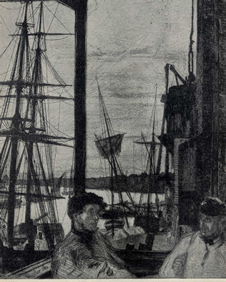
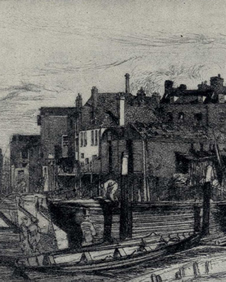
a landmark etching in Whistler’s oeuvre, should be reproduced first, to arrest the reader’s attention. Although not specifically relating to the text at that point, it introduces the overall tone of the piece. Drawn at The Angel tavern, on the south side of the Thames looking across the river to Wapping, it depicts two boatmen smoking long clay pipes in front of a busy Thames full of warehouses and docks, and the masts and rigging of several vessels. With its dark shadows and use of surface tone this etching seems to be the visual summation of Conrad’s portrayal of the river: “Dark and impenetrable at night, like the face of a forest, is the London’s waterside. It is the water-side of water-sides, where only one aspect of the world’s life can be seen and only one kind of men toils on the edge of the stream” (Conrad 1905, 568). At times there is a more direct concurrence between etching and prose description. It is wryly fitting that under the etching Thames Police (Figure 5), which Keppel subtitled “Custom House” and which shows Thames Police Station looking magisterially across the busy Phoenix Wharf, the reader learns more about such “traders, adventurers, fishermen, slave-dealers, pirates, all sorts of unofficial men connected with the sea in a more or less reputable way” (Conrad 1905, 564).
Overall, the etchings are fittingly and intelligently placed. Just as the reader leaves the “hint of loneliness, that soul of the sea” and comes to “the hum of men’s work” which “fills the river with a menacing muttering note as of a breathless, ever-driving gale”, when the water is described as flowing “oppressed by bricks and mortar and stone, by blackened timber and grimed glass and rusty iron, covered with black barges”, the reader is presented with the perfectly suited Black Lion Wharf (Figure 6),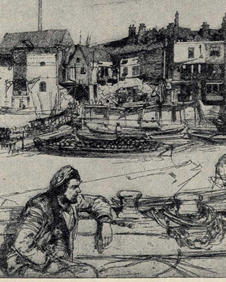
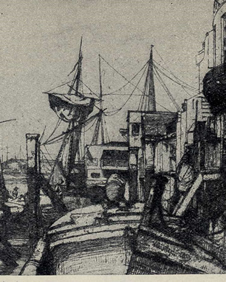
with its smoking chimney stacks, delapidated wharf buildings, and busy barges, and with its focus on the texture of tile and brick, iron and rope, timber and glass. Pennell describes this work as a candidate for “the greatest etching of modern times”.39 And there is a similarly happy pairing when the reader encounters Limehouse (Figure 7)and reads: “The absence of picturesqueness cannot be laid to the charge of the docks opening into the Thames” (Conrad 1905, 570). With its patterning of mooring posts and ship masts, ladders and struts, and the decorative curves of partially unfurled sails, bay windows and wrought iron balconies, Limehouse indeed presents a particularly harmonious and picturesque scene.
However, not all of the etchings work so successfully in their given situ. Billingsgate and The Pool (Figure 8)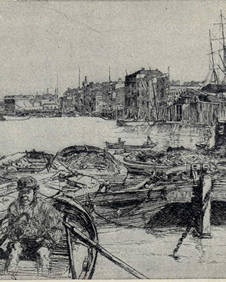
would be better if their positions were reversed. Under Billingsgate we read: “The famous Thames barges sit in brown clusters upon the water with an effect of birds floating on a pond” (Conrad 1905, 565). This is far too prosaic for “one of his most poetic, perhaps his most entirely satisfactory invention” in which, as W. M. Rossetti points out,
the artist has reached a rhythmic arrangement of line which is of very peculiar and exceptional beauty. We speak of course of the cluster of boats, many-masted and many-roped, which are moored together, and just as this portion of the etching is poetical and delicate, so the part that shows the buildings of Billingsgate is substantial, firm and strong.40
The prose beneath The Pool would better fit Billingsgate “The view of ships lying moored in some of the older docks of London brings to my mind the image of a flock of swans kept in the flooded backyard of grimy tenement-houses” (Conrad 1905, 569) suggests beauty within the commonplace, whereas the duck analogy better corresponds to The Pool with its rather plain squat rowing boats and barges.
There are nonetheless deeper correspondences. The way in which Whistler’s Thames etchings seem to come in and out of focus, a technique that has been linked by art historians to an interest in early photography and the science of optics, seems to find its literary counterpart in Conrad’s text.41 Black Lion Wharf is a key example of where some areas, such as the background warehouses and foreground boatman, are described in great detail, while the middle ground is treated very cursorily and suggestively. Similarly, Conrad’s prose is detailed and descriptive, but punctuated with subjective, emotional reflections. At the point in the text where Black Lion Wharf is positioned there are succinct descriptions of “Wharves, landing-places, dock gates, water-side stairs” and of water “whipped up by paddles and screws, overburdened with craft, overhung with chains, overshadowed by walls making a deep gorge for its bed, filled with a haze of smoke and dust” (Conrad 1905, 576). This is followed by a rather poetic and whimsical aside:
“It recalls a jungle by the confused and impenetrable aspect of the buildings that line the shore, not according to a planned purposes, but as if by accident, from scattered seeds. Like the matted growth of bushes and creepers veiling the silent depths of an unexplored wilderness they hide the depths of London’s infinitely varied, vigorous, seething life” (Conrad 1905, 567).
Examples of such changes in focus, a blurring of the objective and subjective, can be cited throughout Conrad’s text.42 Katharine Lochnan has linked Whistler’s technique to an early appreciation of Turner, noting Ruskin’s description of Turner’s application of optics in painting in Volume One of Modern Painters.43 Reviewing The Mirror of the Sea, The Outlook commented suggestively: “Mr. Conrad has seen the sea with a Turner’s eyes”.44 Writing on Turner and Conrad, Wendy Faris has also drawn attention to what she calls an “oscillation between surface and depth” in the work of both men.45 In many ways Whistler is a step closer to Conrad than Turner, and The Metropolitan Magazine’s decision to use etchings by Whistler to illustrate “London River” makes greater sense, and acquires additional meanings, in the context of Conrad’s prose.
Whistler was a key figure in the Etching Revival which promoted the freedom and expressiveness of the original painter-etcher over the mere reproductive printmaker. His Thames etchings, which had been published as independent works of art, not illustrations, over thirty years before their appearance in The Metropolitan Magazine, are in no way subordinate to Conrad’s text. Whistler’s Thames etchings stand out in contrast to those illustrations by the Edinburgh artist David B. Waters (fl. 1887–1910) accompanying Sections I–VI of The Mirror of the Sea in the Pall Mall Magazine between January and June 1905, or, indeed, those of high profile maritime illustrators such as Clifford W. Ashley that accompanied Conrad’s later works published in The Metropolitan Magazine from 1912.46 These images were more conventional fare in the sense that they supported the text, each image specifically relating to a passage of text and with a quote underneath. In contrast, Whistler, apart from a few excursions in that direction as a young man, and a very unusual etching for E. W. Gosse’s Cecil Lawson: A Memoir (1883), did not undertake illustrations.47 Famously, he refused to pander to what he called “[t]he vast majority of English folk [who] cannot and will not consider a picture as a picture, apart from any story which it may be supposed to tell.”48
“London River” is not a fictional narrative that requires elements of the story to be emphasised and highlighted by means of visual illustrations. It is a work of travel literature that muses on and describes a landscape, that goes off on tangents, and indulges in literary speculations. The Metropolitan Magazine could have chosen to illustrate Conrad’s article with photographs of the Thames, as it had with Sidney Allan’s “Along the Seashore” (September 1904).49 But this would have failed to bring out the subtleties and suggestiveness of the prose. Conrad’s text is itself highly visual and sympathetic to a Whistlerian eye. When Conrad writes of the estuary lightship as “a tiny warm speck of crimson lost in an immensity of gray tones”, and, again, of “the warm speck of red upon the tones of drab and gray”, he could almost be describing one of Whistler’s seascapes or Thames Nocturnes.50
Conrad obviously felt a connection to Whistler, to whom he refers directly in his short story “The Partner” (1911):
I was looking at them—an acre or more of black dots scattered on the steel-grey shades of the level sea, under the uniform gossamer grey mist with a formless brighter patch in one place—the veiled whiteness of the cliff coming through, like a diffused, mysterious radiance. It was a delicate and wonderful picture, something expressive, suggestive, and desolate, a symphony in grey and black—a Whistler.51
In 1906 the Daily Mail reviewed “The Faithful River” as if Conrad was indeed himself an artist: “‘The Faithful River’ is our own Thames, which, because it has impressed Mr. Conrad so deeply, he is able to paint most vividly.”52
Yet Whistler’s Thames etchings are more fitting here than his later and more suggestive Nocturnes and river views (Figure 9).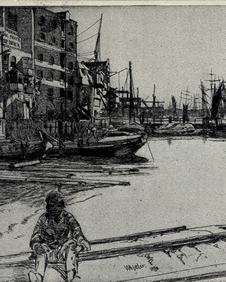
The clarity of the etchings can be seen to fit the precision and succinctness of Conrad’s descriptive prose:
Just round the corner, as it were, upon a shore defined with stone blocks and wooden piles, a white mast, slender like a stalk of straw and crossed by a yard like a knitting-needle flying the signals of flag and balloon, appears near the dock gates. Mastheads and funnel tops of ships peep above the range of corrugated iron roofs. This is Tilbury dock. (Conrad 1905, 567)
Text and image complement and cohere. Indeed, the Academy commented on the difference between “London River” and Conrad’s more impressionistic writing by noting that the text is “illuminating rather than suggestive”: “His words clear your vision, but they do not set you dreaming.”53 Possibly meant as censure, it nonetheless demonstrates the fittingness of Whistler’s early Realist etchings as “illustrations”, compared to his more suggestive, impressionistic later works.
Thinking about the broader oeuvres of both men, they pair up rather naturally. Whistler was an aesthete, a British Impressionist; Conrad was a literary Impressionist. Whistler was concerned with art for art’s sake; Conrad was concerned less with plot than with description and the beauty of language experienced through the senses. Reviewing The Nigger of the “Narcissus”, the Glasgow Evening News wrote that it was “destitute of plot” and that “its appeal depends upon its treatment of the characters of the seamen, its impressions of the ocean”.54 Whistler’s tendency to reduce the picture plane to formal qualities, which can be interpreted as proto-Modernist, would have appealed to Conrad, whose writings were celebrated by Modernist writers such as T. S. Eliot and Ezra Pound. Whistler’s paintings can be seen as anti-heroic and anti-establishment, as were Conrad’s characters.
Conrad himself saw the correspondences. Writing to Edinburgh publisher William Blackwood on 31 May 1902, he famously declared:
I am modern, and I would rather recall Wagner the musician and Rodin the Sculptor who both had to starve a little in their day—and Whistler the painter who made Ruskin the critic foam at the mouth with scorn and indignation. They too have arrived. They had to suffer for being “new”. And I too hope to find my place in the rear of my betters.55
In the same letter he described his work as “not an endless analysis of affected sentiments” but as “action observed, felt and interpreted with an absolute truth to my sensations (which are the basis of art in literature)”.56 Conrad’s statement is strongly reminiscent of Whistler’s declaration: “Art should be independent of all clap-trap— should stand alone, and appeal to the artistic sense of eye or ear, without confounding this with emotions entirely foreign to it, as devotion, pity, love, patriotism, and the like.”57 In Chapter 9 of The Mirror of the Sea, Conrad likened the craft of seafaring to painting, and sailors to Royal Academicians, and he even permitted himself a certain Whistlerian anti-establishment disdain, describing them as “never startled by a touch of originality” and going “about solemnly in the assurance of their consecrated and empty reputation.” The captain, like the President of the Royal Academy, was “always on stereotyped lines, unsuggestive”—and inspiring boredom.
Conrad’s pronouncements on the art of writing are remarkably similar to Whistler’s on the art of painting in several respects. It is particularly worth comparing aspects of Whistler’s “Ten O’Clock Lecture” (1885) with Conrad’s 1897 “Preface” to The Nigger of the “Narcissus”, a kind of literary manifesto in which he unleases “the supreme cry of Art for Art itself”.58 The tone of each text is very similar, with both authors adopting the lofty manner of the teacher or prophet, talking of gods and temples, looking to the past, and decrying the bad workman and the mere copyist. Art, writes Conrad, “is not in the unveiling of one of those heartless secrets which are called the Laws of Nature”. Whistler likewise declares: “To say to the painter, that nature is to be taken, as she is, is to say to the player, that he may sit on the piano!”59 According to Whistler “the artist is born to pick, and choose, and group with science, these elements, that the result may be beautiful—as the musician gathers his notes, and forms his chords, until he brings forth from chaos, glorious harmony”.60 Similarly, Conrad expresses concern for the careful placement and grouping of words:
an unremitting never-discouraged care for the shape and ring of sentences that an approach can be made to plasticity, to colour, and that the light of magic suggestiveness may be brought to play for an evanescent instant over the commonplace surface of words: of the old, old words, worn thin, defaced by ages of careless usage.61
Echoing Whistler, Conrad reproves those who look to literature “to be edified, consoled, amused; who demand to be promptly improved, or encouraged, or frightened, or shocked, or charmed”. In the Preface to The Nigger of the “Narcissus” Conrad states his intention “by the power of the written word to make you hear, to make you feel [...] before all, to make you see”, and he repeatedly talks about “form”, “colour”, “light”, and “shadows” in the manner of a pictorial artist. His assertion that “A work that aspires, however humbly, to the condition of art should carry its justification in every line”, recalls Walter Pater’s famous statement in “The School of Giorgione”, a text often quoted in relation to Whistler and Aestheticism, that “All art constantly aspires towards the condition of music”.62 In his “The Red Rag” (1878), Whistler had already declared, “As music is the poetry of sound, so is painting the poetry of sight, and the subject-matter has nothing to do with harmony of sound or of colour”.63 Conrad too argues that his writing, like art and music, is sensory, emotional, and suggestive:
Fiction—if it at all aspires to be art—appeals to temperament. And in
truth it must be, like painting, like music, like all art, the appeal of one temperament to all the other innumerable temperaments whose subtle
and resistless power endows passing events with their true meaning,
and creates the moral, the emotional atmosphere of the place and time.64
In the pages of The Metropolitan Magazine Conrad’s text found its visual equal. The American art critic and writer Henry James, who was a friend of both men, had written to Whistler in 1897 that “the arts are one, and with the artist the artist communicates.”65 Conrad felt this sisterhood of the arts, stating his intention to make the reader “see” through the power of the written word. He was also very concerned with the actual presentation and look of his works. As he told the American lawyer and collector John Quinn on 22 July 1914: “There’s more in the typographical aspect of a work than people realise. A book is written for the eye”.66 In bringing together Conrad’s “London River” and Whistler’s Thames etchings, The Metropolitan Magazine facilitated a union of larger aesthetic ideals. Conrad did not find himself humbly in the train of his predecessors, as he had earlier suggested, but in Whistler’s own company, that is to say, in the vanguard of artistic and literary achievement.
Endnotes
1. Conrad to Rothenstein, 18 April 1904, in William Rothenstein, Men and Memories: Recollections of William Rothenstein 1900-1922 (London: Faber & Faber, 1932), 66. Augustus John was one of the artists promoted in the early years of Rothenstein and John Fothergill’s Carfax Gallery, founded in St James’, Piccadilly, in 1898. Augustus John’s sister, Gwen John, who also exhibited there, studied under Whistler at the Académie Carmen in Paris.↩
2. First appeared as “London River” in The World Today (December 1904), and then subsequently in The World’s Work (London) (December 1904) and The Metropolitan Magazine (February 1905): 562-71; and then as “London’s River” in The London Magazine 16, no. 95 (July 1906), illustrated with etchings by British painter and illustrator Edgar Wilson (1861-1918). ↩
3. The Academy (20 October 1906): 393-94 ↩
4. Linda Merrill, A Pot of Paint: Aesthetics on Trial in Whistler v. Ruskin (Washington & London: Smithsonian Institution Press, 1992), 141.↩
5. Richard Dorment & Margaret F. MacDonald, James McNeill Whistler (London: Tate Gallery, 1994), 115-19. John Stape, The Several Lives of Joseph Conrad (London: William Heinemann, 2007), 27.↩
6. Responding to Whistler’s painting Nocturne in Black and Gold: The Falling Rocket, on display in 1877 in the newly opened Grosvenor Gallery in London, Ruskin accused the artist of ‘flinging a pot of paint in the public’s face’, a commented he published in the pages of Fors Clavigera (letter 79, July 1877). E. T. Cook & Alexander Wedderburn (eds), The Complete Works of John Ruskin, 39 vols (London, 1903-12), vol. 29, 160.↩
7. Rothenstein, Men and Memories, 44.↩
8. Whistler as reported by Alan Summerly Cole, [15 July 1878], Glasgow University Library, MS Whistler W759, in The Correspondence of James McNeill Whistler, 1855-1903, ed. by Margaret F. MacDonald, Patricia de Montfort and Nigel Thorp, including The Correspondence of Anna McNeill Whistler, 1855–1880, ed. by Georgia Toutziari, online edition (Glasgow: Centre for Whistler Studies, University of Glasgow, 2003-2006), http://www.whistler.arts.gla.ac.uk/correspondence (GUW 06765).↩
9. James McNeill Whistler, Mr. Whistler’s “Ten O’Clock” (London: Chatto & Windus, 1888), 24. Lecture subsequently given in Cambridge on 24 March 1885, and finally in Oxford on 30 April 1885.↩
10. Oil Paintings, Water Colors, Pastels and Drawings: Memorial Exhibition of the Works of Mr. J. McNeill Whistler, Copley Society, Boston, February 1904; Memorial Exhibition of the Works of the late James McNeill Whistler, First President of The International Society of Sculptors, Painters and Gravers, New Gallery, London, 22 February–15 April 1905; and Oeuvres de James McNeill Whistler, Palais de l’Ecole des Beaux-Arts, Paris, May 1905.↩
11. Frank Luther Mott, A History of American Magazines, vol. 4, 1885-1905 (Cambridge, MA: Harvard University Press, 1957), 46.↩
12. Conrad to James B. Pinker, 18 April 1904, in Frederick R. Karl & Laurence Davies (eds), The Collected Letters of Joseph Conrad, 9 vols (Cambridge University Press, 1983-2007), 3:133.↩
13. Max Beerbohm, “Whistler’s Writing”, Metropolitan Magazine 20, no. 6 (September 1904): 731.↩
14. Although the book was dated 1898. Robert Kimbrough (ed.), The Nigger of the “Narcissus”: Joseph Conrad (New York: W. W. Norton & Company, 1979), 111.↩
15. Margaret F. MacDonald, James McNeill Whistler: Drawings, Pastels and Watercolours: A Catalogue Raisonnée (New Haven & London: Yale University Press, 1995), 553, no. 1534.↩
16. Andrew McLaren Young, Margaret MacDonald, Robin Spencer & Hamish Miles, The Paintings of James McNeill Whistler, 2 vols (New Haven & London: Yale University Press, 1980), 1:223, no. 531.↩
17. Elisabeth Robins & Joseph Pennell, The Life of James McNeill Whistler, 2 vols (London: William Heinemann, 1908).↩
18. Margaret F. MacDonald, Grischka Petri, Meg Hausberg and Joanna Meacock, James McNeill Whistler: The Etchings, a catalogue raisonné, University of Glasgow, 2012 (referred to as G.), http://etchings.arts.gla.ac.uk.↩
19. “English Etching”, The Standard (25 April 1878): 2.↩
20. Plates acquired by Charles Lang Freer (1856-1919) in 1896. See “History of the Thames Set”, in MacDonald, Petri, Hausberg and Meacock, Whistler: The Etchings.↩
21. Catalogue of an Exhibition of Etchings, Dry-points, and a few Drawings by Whistler; with an introduction by Joseph Pennell, October 14th to November 5th, 1904 (New York: Frederick Keppel & Co., 1904), 3.↩
22. Frederick Keppel, The Gentle Art of Resenting Injuries; being some Unpublished Correspondence Addressed to the Author of “The Gentle Art of Making Enemies” (New York, Frederick Keppel, 1904). Walter Greenwood Forsyth & Joseph LeRoy Harrison, “Guide to the Study of James Abbott McNeill Whistler”, State Library Bulletin, Bibliography No. 1 (May 1895). Whistler to Keppel, 7 June 1896, Library of Congress, Manuscript Division, Pennell-Whistler Collection, PWC, in MacDonald, de Montfort and Thorp, Correspondence of Whistler (GUW 09177). “Frederick Keppel, 1845-1912”, in MacDonald, Petri, Hausberg and Meacock, Whistler: The Etchings. ↩
23. Frederick Keppel, “One Day with Whistler”, The Reader 3, no. 2 (January 1904): 145-51.↩
24. Robert Speaight, William Rothenstein: The Portrait of an Artist in his Time (London: Eyre & Spottiswoode, 1962), 40.↩
25. Speaight describes it as a “girl’s school”, Rothenstein, 21.↩
26. Exhibition invitation, Whistler to L. E. Lefèvre, [2/16] May [1889], Kenneth Rendell, New York, in MacDonald, de Montfort and Thorp, Correspondence of Whistler (GUW 13698). Young, MacDonald, Spencer & Miles, Paintings of James McNeill Whistler, 1:83, no. 137.↩
27. William Rothenstein, The Portrait Drawings of William Rothenstein (London: Chapman & Hall, 1926).↩
28. Rothenstein also tried to persuade Bradford Art Gallery to buy works by Walter Sickert, Augustus John and Philip Wilson Steer. Sir William Rothenstein 1872-1945: A Centenary Exhibition, exh. cat. (Bradford City Art Gallery & Museums, 1972).↩
29. Reverend Joseph Slapkins, The Parson and the Painter: Their Wanderings and Excursions among Men and Women (London, 1891). Alfred Allison was the former editor and owner of the St Stephen’s Review, in which the work was originally printed serially in 1889-1890. Whistler to Rothenstein, [August/September 1893?], Glasgow University Library, Whistler R147, in MacDonald, de Montfort and Thorp, Correspondence of Whistler (GUW 05251); Whistler to Rothenstein, [14 February 1894], Houghton Library, Harvard University, Cambridge, MA, bMS Eng. 1148 (1610), in MacDonald, de Montfort and Thorp, Correspondence of Whistler (GUW 10952). W. Allison, My Kingdom for a Horse, Grant Richards (London, 1919), 322. Simon Houfe, Phil May: His Life and Work, 1864-1903, (Aldershot: Ashgate, 2002), 42-53.↩
30. Rothenstein, Men and Memories, 41.↩
31. Wyndham Lewis, “Fifty Years of Painting: Sir William Rothenstein’s Exhibition”, written for London Mercury in 1938 on the occasion of an exhibition at the Leicester Galleries, but not published; Apollo 91 (March 1970): 220.↩
32. Conrad to R. B. Cunninghame Graham, [9 June? 1903], in Karl & Davies, Collected Letters, 3:41. ↩
33. Rothenstein, Men and Memories, 69.↩
34. Conrad to Edward Garnett, 29 September 1898, in Karl & Davies, Collected Letters, 2:94.↩
35. MacDonald, Whistler: Drawings, Pastels and Watercolours, 342-43, no. 903.↩
36. Conrad to Edward Garnett, 29 September 1898, in Karl & Davies, Collected Letters, 2:95.↩
37. William Michael Rossetti, “Mr Whistler’s Etchings”, The Reader (4 April 1863).↩
38. Joseph Conrad, “London River”, Metropolitan Magazine (February 1905), 565-66.↩
39. Joseph Pennell, letter to Daily Chronicle, London, 22 February 1895, quoted in Catalogue of an Exhibition of Etchings, Dry-points, and a few Drawings by Whistler, 13.↩
40. “Notes on Art and Archaeology”, The Academy (15 December 1877), 562.↩
41. Katharine A. Lochnan, The Etchings of James McNeill Whistler (New Haven & London: Yale University Press, 1984), 95-96. ↩
42. John G. Peters, Conrad and Impressionism (Cambridge: Cambridge University Press, 2001), 35-36.↩
43. Lochnan, Etchings, 96-98.↩
44. “From Departure to Landfall”, The Outlook (13 October 1906), 480. ↩
45. Wendy B. Faris, “The ‘Dehumanization’ of the Arts: J. M. W. Turner, Joseph Conrad, and the Advent of Modernism”, Comparative Literature 41, no. 4 (autumn 1989): 315-16, 321.↩
46. Laura L. Davis, “‘Not so much art as a financial operation’: Conrad and Metropolitan Magazine”, Conradiana 41, no. 2-3 (2009): 259-63.↩
47. Whistler, Sketch after Cecil Lawson’s “Swan and Iris”, 1882, etching (G.247). ↩
48. Whistler, “The Red Rag”, in “Celebrities at Home. No. XCII. Mr Whistler at Cheyne-Walk”, The World (22 May 1878): 4-5.↩
49. Sidney Allan, “Along the Seashore”, The Metropolitan Magazine 20, no. 6 (September 1904): 698-705, illustrated with photographs by Rudolf Eickemeyer, Jr.↩
50.Joseph Conrad, “London River”, Metropolitan Magazine (February 1905): 565.↩
51. Joseph Conrad, ‘The Partner’, Harper’s Magazine 123 (November 1911): 851.↩
52. The Daily Mail (16 October 1906): 2. ↩
53. The Academy (20 October 1906): 393-94. ↩
54. Glasgow Evening News (16 December 1897): 2. ↩
55. Karl & Davies, Collected Letters, 2:418.↩
56. Karl & Davies, Collected Letters, 2:418. ↩
57. Whistler, “The Red Rag”, The World (22 May 1878): 4-5.↩
58. Conrad’s “Preface” was first published as “Author’s Note” in New Review 17 (December 1897): 628-31. It was reprinted as “The Art of Fiction” in Glasgow Herald (13 March 1905). The assistant editor and chief leader-writer of the Glasgow Herald at this time, William Wallace (1843-1921), was a well respected literary scholar who had developed the paper’s cultured reputation. Interestingly it was he who had eloquently argued in the pages of the Herald for the Corporation of the City of Glasgow to buy Whistler’s Arrangement in Grey and Black, No. 2: Portrait of Thomas Carlyle in 1891. See Alastair Phillips, Glasgow’s Herald 1783-1983 (Glasgow: Richard Drew, 1983), 106-9.↩
59. Whistler, Mr. Whistler’s “Ten O’Clock” (London: Chatto & Windus, 1888), 14. ↩
60. Whistler, “Ten O’Clock”, 14.↩
61. Conrad, “Preface”, The Nigger of the “Narcissus”: A Tale of the Sea (London: Heinemann, 1897).↩
62. Walter Pater, “The School of Giorgione”, Fortnightly Review, 3rd edition (1888). ↩
63. Whistler, “The Red Rag”, The World (22 May 1878): 4-5.↩
64. Conrad, “Preface”, Nigger of the “Narcissus”.↩
65. Henry James to Whistler, 25 February 1897, Glasgow University Library, MS Whistler J25, in MacDonald, de Montfort & Thorp, Correspondence of Whistler (GUW 02404).↩
66. Karl & Davies, Collected Letters, vol. 5, 403. Davis, “Conrad and Metropolitan Magazine”, Conradiana 41, no. 2-3 (2009): 259. ↩

Dr Joanna Meacock is Curator of British Art at Glasgow Museums. She worked on the online projects, The Correspondence of James McNeill Whistlerand James McNeill Whistler: The Etchings, a catalogue raisonné. She is co-author of A Rossetti Family Chronology (2007) with Dr Alison Chapman, and has written several articles on Whistler, Rossetti, the Etching Revival and the Aesthetic Movement.
Back to the start of the essay.